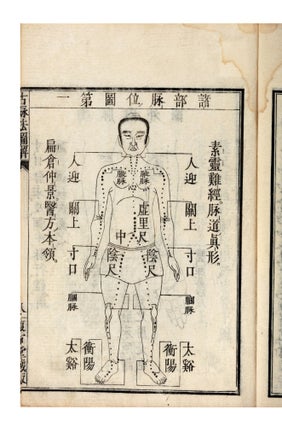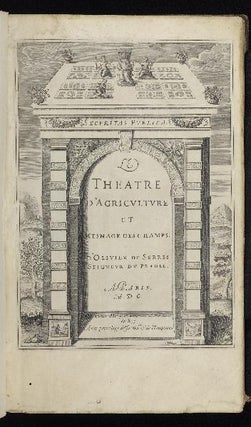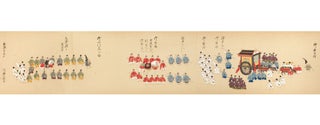The Most Influential of All Sutra
Eight scrolls, finely woodblock-printed, of the complete Lotus Sutra [S.: Saddharmapundarikasutra; J.: Myohorengekyo 妙法蓮華経].
17 characters per column; 24 columns per sheet. Each sheet: ca. 450 mm. long. Text-block height: 207 mm. Eight scrolls (297 x 10,785; 12,480; 11,600; 10,430; 11,190; 10,190; 10,130; 9000 mm.), all with front endpapers speckled on inside with square-cut gold, silver, & copper foil, outer endpapers dyed reddish-orange & with clouds of gold, silver, & copper mottling. Seven of the eight scrolls have on the outside of the front endpaper an orig. label stating “Myohorengekyo” [“Glory to the Dharma of the Lotus Sutra”], and its volume number. All with wooden rollers. [Japan: late Muromachi to early Edo].
A handsomely produced woodblock-printed edition of the complete Lotus Sutra in 28 chapters, originally translated into Chinese by Kumarajiva and completed in 406. The Lotus Sutra is the most influential of all sutra and “was highly influential in East Asia, inspiring both a range of devotional practices as well as the creation of new Buddhist schools that had no Indian analogues.”–Buswell & Lopez, eds., The Princeton Dictionary of Buddhism, p. 730. For several Japanese schools of Buddhism, the Lotus Sutra remains their central text and is considered to be the only valid Buddhist sutra for the Degenerate Age.
These handsome scrolls have been printed on high-quality paper (gampi, or mulberry fibers), with a light sprinkling of mica dust, and printed in bold, thick strokes, using black lacquer-like sumi ink, typical of Kamakura and Muromachi Kasuga-ban printings.
Kumarajiva (344-413), Buddhist monk, scholar, missionary, and translator, who came from the Silk Road kingdom of Kucha, was famous for his encyclopedic knowledge of Indian and Vendantic learning. He was the greatest translator of Buddhist scripture from Sanskrit into Chinese, and it was largely owing to his efforts and influence that Buddhist religious and philosophical ideas were disseminated in China. Following many years of study in Kucha and Kashmir, he arrived in Chang’an (now Xi’an), in 401, with a great reputation. He became known as “teacher of the nation.” There, he headed a famous school of translators, and together they translated many important texts into Chinese, including the Vimalakirti, the Diamond, the Lotus, and the Amitabha sutra.
It is most unusual to find on the market an early printing of a long sutra, like the Lotus Sutra, textually complete; usually one finds just one part of a text in one scroll. Complete sets of this work are of the greatest rarity.
A fine set, clean and fresh. The third scroll has some worming to the final quarter of the text, touching and affecting characters. At the end of the final scroll is a manuscript note, dated “9 July 1646,” signed by a Buddhist practitioner named Nichi’en. At the beginning of the first scroll and at the end of the final scroll, we find the names in manuscript of two donors, Jo’an and Myo’an, members of the Nichiren sect. Above their signatures in the eighth scroll, they have written in a very beautiful calligraphic style, “Namumyohorengekyo Nichiren Daibosatsu.”
❧ K.B. Gardner, “Centres of Printing in Medieval Japan: late Heian to early Edo period” in British Library Occasional Papers 11. Japanese Studies (ed. by Yu-Ying Brown), London: 1990, p. 159–”The term Kasuga-ban became used more loosely, in a wider sense, to denote publications of the Nara monasteries in general, not only of the Kofukuji. The printing of Kasuga-ban in this broader sense flourished throughout the Kamakura period and up to the end of Muromachi (ca. 1570).”.
Price: $35,000.00
Item ID: 8674

![Item ID: 8674 Eight scrolls, finely woodblock-printed, of the complete Lotus Sutra [S.: Saddharmapundarikasutra; J.: Myohorengekyo 妙法蓮華経]. LOTUS SUTRA.](https://jonathanahill.cdn.bibliopolis.com/pictures/8674.jpg?width=768&height=1000&fit=bounds&auto=webp&v=1673468848)
![Eight scrolls, finely woodblock-printed, of the complete Lotus Sutra [S.: Saddharmapundarikasutra; J.: Myohorengekyo 妙法蓮華経].](https://jonathanahill.cdn.bibliopolis.com/pictures/8674_2.jpg?width=320&height=427&fit=bounds&auto=webp&v=1686229886)



